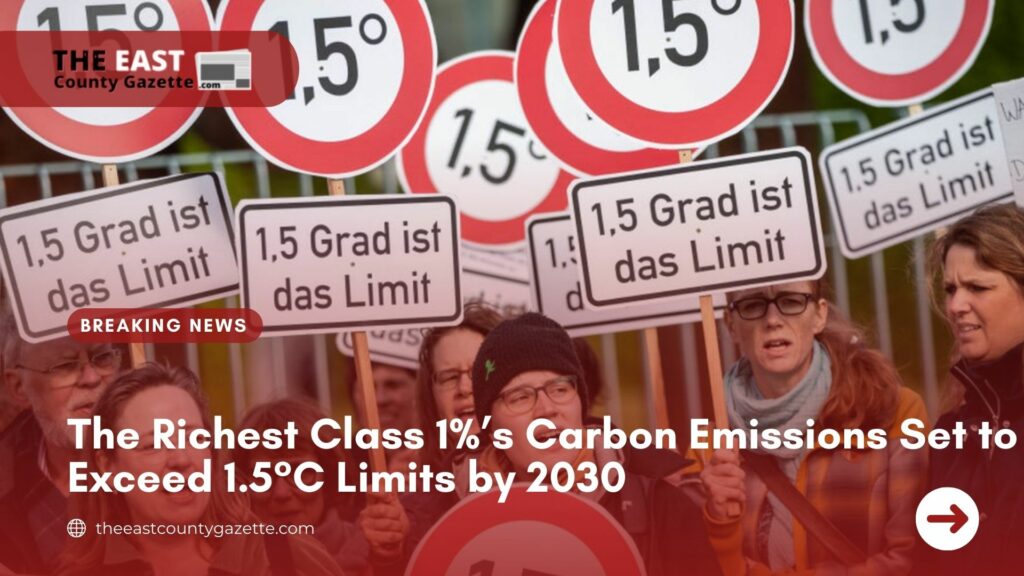According to a new study, the carbon footprints of the richest 1 percent of people on Earth are expected to exceed 1.5°C by 30 times what was agreed upon in the Paris Agreement in 2030.
This announcement comes as participants at the COP26 meeting in Glasgow are grappling with how to keep this goal of carbon emission alive.
In 2015, governments agreed to the goal of limiting global heating to 1.5°C above pre-industrial levels.
While reducing emissions is important, current pledges fall far short of meeting the needs.
Every human on Earth would have to emit less CO2 than 2.3 tons per year by 2030 to keep the target within this guardrail; that is roughly half of the average footprint we have today.
Recommended Read: Elon Musk faces a tax bill of more than $15 billion!
A study released today estimates how the carbon footprints of richer and poorer people around the world will be affected by governments’ pledges, based on research by Oxfam and the Institute for European Environmental Policy (IEEP).
Populations and income groups around the world are treated as if they were one nation. According to the study, by 2030:
The poorest half will still emit far below the 1.5°C line in 2030.
There will be a 30x and a 9x difference in wealth for the richest 1 percent and 10% of people, respectively.
It would take one of the wealthiest 1 percent to reduce their carbon footprint by approximately 97 percent compared with what we have today in order to achieve the target.
Recommended Read: 89 Year Old Completes Ph.D. in Physics!
Yet the middle 40 percent are projected to reduce their per capita carbon emissions by 9 percent between 2015 and 2030. This is encouraging for the Paris Agreement of 2015.
A group with the highest per capita emissions growth rates from 1990 to 2015 is mostly citizens of middle-income countries, such as China and South Africa.
Taking total emissions into account and not individual emissions, the richest 1 percent will be responsible for 16 percent of total emissions by 2030, compared to 13 percent in 1990 and 15 percent in 2015.
By 2030, no matter what the other 90 percent do, the richest 10 percent alone would surpass the 1.5°C-aligned emissions levels.
In a statement, Nafkote Dabi, an Oxfam Climate Policy Lead, stated:
“The emissions from a single billionaire spaceflight would exceed the lifetime emissions of someone in the poorest billion people on Earth. A tiny elite appears to have a free pass to pollute. Their oversized emissions are fueling extreme weather around the world and jeopardizing the international goal of limiting global heating. The emissions of the wealthiest 10 percent alone could send us beyond the agreed limit in the next nine years. This would have catastrophic results for some of the most vulnerable people on Earth who are already facing deadly storms, hunger, and destitution.”
Recommended Read: First Time In 15 Months Japan Reports No COVID-Related Deaths.
There will be changes in the geography of carbon inequality as well. This will be due to a larger share of emissions of 10 linked to citizens in middle-income countries from the world’s richest 1%.
China will contribute almost a quarter (23%) of the emissions of the richest 1% by 2030, more so, the US a fifth (19%), and India a tenth (11%).
IEEP’s Director of Low Carbon and Circular Economy, Tim Gore, stated in his briefing:
“The global emissions gap to keep the 1.5°C Paris goal alive is not the result of the consumption of most of the world’s people: it reflects instead the excessive emissions of just the richest citizens on the planet. To close the emissions gap by 2030, it is necessary for governments to target measures at their richest, highest emitters ―the climate and inequality crises should be tackled together. That includes both measures to constrain luxury carbon consumption like mega yachts, private jets and space travel, and to curb climate-intensive investments like stock-holdings in fossil fuel industries.”
Recommended Read: The Feds Put Up $10 Million For Anyone With Key Information About DarkSide Ransomware Group.
According to Emily Ghosh, a scientist at the Stockholm Environment Institute: “Our research highlights the challenge of ensuring a more equitable distribution of the remaining and rapidly diminishing global carbon budget. If we continue on the same trajectory as today the stark inequalities in income and emissions across the global population will remain, challenging the equity principle at the very heart of the Paris Agreement. Analysis of carbon inequality must urgently be put at the center of governments efforts to reduce emissions.”
In line with their fair share, Oxfam suggested world leaders target deeper emissions reductions by 2030.
It also called on these leaders to ensure that the richest people on both the global and national scales make the most drastic cuts.
Recommended Read: U.S. Police Offers $30,000 Cash Reward For Info About Suspect Who Shot Officer.
Through greener lifestyles and investments, the wealthiest citizens can dramatically accelerate the transition to a low-carbon economy.
By utilizing their political influence and investments in favor of a low-carbon economy, the richest citizens can also fast-track this process dramatically.

